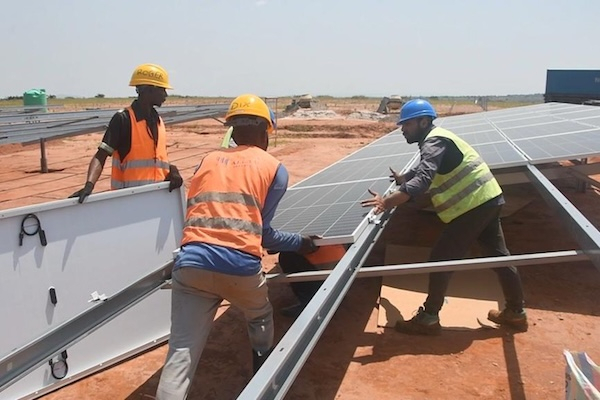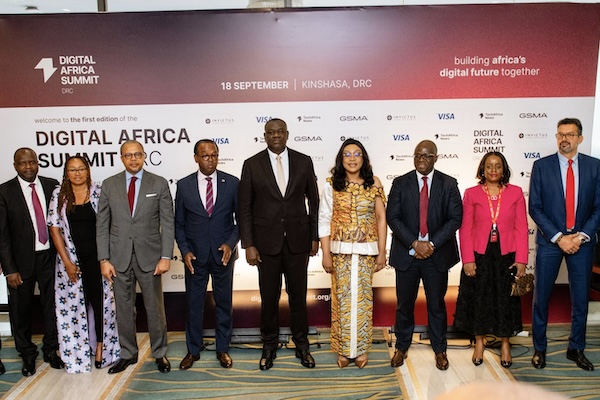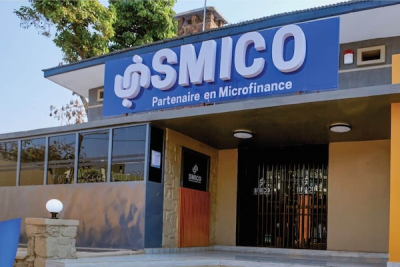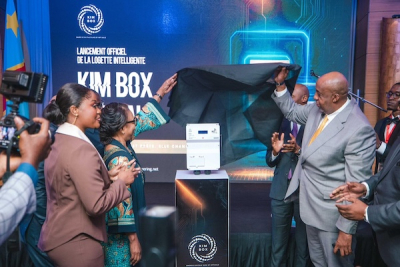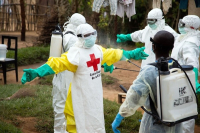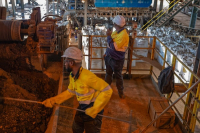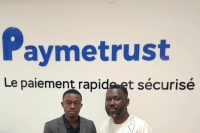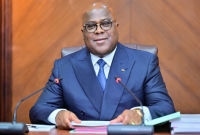
News (571)
Chinese electronics component maker Shenzhen Hongfuhan Technology is set to be the main investor in a 30 megawatt (MW) solar power plant designed to supply the Kamoa-Kakula mining complex in the Democratic Republic of Congo (DRC).
Citing Chinese media, sources reported on Wednesday, October 1, 2025, that Hongfuhan announced it would soon sign a partnership agreement with its compatriot, Green World Energy and Green World's parent company, the Construction and Commercial Development Company (SDCC), to finance the $198 million project.
Hongfuhan, a Shenzhen-based firm that recently expanded into the solar sector, plans to invest $158.4 million in the project, with Green World/SDCC covering the remaining balance.
The pending agreement includes the creation of a joint venture, with shares distributed proportionate to the investment: 80 percent for Hongfuhan and 20 percent for Green World/SDCC. Green World/SDCC will handle construction, installation, operation, and maintenance, while the majority shareholder, Hongfuhan, will exercise control.
In April 2025, Kamoa Copper, the owner of the Kamoa-Kakula mine, signed a power purchase agreement with Green World Energy. The Beijing-based firm committed to financing, building, and operating a solar plant with a constant power capacity of 30 MW. Hongfuhan states the contract duration is 15 years.
High Profitability Expected
During the first 5.5 years—a period encompassing the construction phase and deemed necessary to recoup the initial investment—net profits will be shared pro rata to the joint venture stakes. After that, the distribution will shift to 76 percent for Hongfuhan and 24 percent for SDCC.
Kamoa Copper plans to boost its total solar capacity to 120 MW to power Kamoa-Kakula, which has an annual copper production capacity of 600,000 metric tons. The mining company has also signed an agreement with CrossBoundary Energy DRC to finance, build, and operate a separate 30 MW constant-power solar plant, with a contract duration of 17 years.
Both solar projects, including grid connection, are expected to be completed by the end of July 2026. By that deadline, the Kamoa-Kakula complex’s electricity needs are projected to reach 240 MW. The company aims to cover this demand exclusively with green energy, retiring its diesel generators.
Beyond solar, Kamoa is also relying on hydropower, specifically through the rehabilitation of Inga II’s Turbine 5 (178 MW). Full commissioning of the turbine is expected in 2026 after network reinforcement. With these combined projects, Kamoa Copper anticipates being able to reduce its electricity imports from Zambia and Mozambique.
Timothée Manoke
• GSMA estimates telecom reforms could generate 9,800 billion Congolese francs ($3.7 billion) in GDP by 2029.
• Mobile operators in DRC face a tax burden of 91% of profits, among the heaviest compared to mining (71%) and banking (34%).
• The sector could connect 9.7 million new mobile internet users and unlock $3.2 billion in value across mining, agriculture, and public services.
The first Digital Africa Summit in Kinshasa on Sept. 18 became a platform for mobile operators to advocate tax and regulatory reforms in the Democratic Republic of Congo (DRC). The push relied on a report by the GSMA, the global mobile industry association, titled “Driving Economic Growth through Digital Transformation in the DRC.”
Angela Wamelo, GSMA’s Africa director, said the reforms could add 9,800 billion Congolese francs ($3.7 billion) to GDP and connect 9.7 million additional mobile internet users by 2029. The report projected that mobile adoption could release more than 8,600 billion Congolese francs ($3.2 billion) in value across mining, agriculture, and public services.
“The Democratic Republic of Congo has the opportunity to leapfrog into a digital-driven economy,” Wamelo said. “But to realize this potential, reforms in taxation, spectrum management, and energy infrastructure must be a priority. We aim to regulate this sector in DRC to make it more transparent and attract investors,” she added.
A separate GSMA report from June, “Mobile Sector Taxation: Comparative Tax Burden in DRC,” highlighted the heavy fiscal environment operators face. It said mobile operators pay on average 91% of their profits in taxes, compared with 71% for mining companies and 34% for retail banks. The report blamed multiple sector-specific levies, often calculated on revenues, for deterring investment and limiting service expansion.
The GSMA urged simplification and harmonization of taxes. It recommended modernizing fiscal frameworks through rationalization of sectoral taxes to lower consumer prices and encourage investment. It also called for a collaborative national framework, coordination of energy and digital policies, expanded spectrum access, license reform, skills development through public-private partnerships, and integration of mobile platforms into education, health, and government services.
The government, facing major financing needs, has argued that telecom operators must pay their “fair share” of taxes. Some officials questioned the fiscal contribution of multinational operators, noting that some had not declared taxable profits in nearly two decades, raising suspicions of tax avoidance.
Despite these concerns, Digital Economy Minister Augustin Kibassa Maliba welcomed the GSMA report. He described it as a “clear diagnostic” of the sector’s progress and challenges. “We have the responsibility to transform the recommendations of this report into concrete actions, because it is through them that we will build a true digital economy,” he said.
According to GSMA, the mobile sector contributed an estimated $63–64 billion to DRC’s GDP in 2022 and $66 billion in 2023.
This article was initially published in French by Ronsard Luabeya
Adapted in English by Ange Jason Quenum
• President Félix Tshisekedi pledged $1 billion in public spending from 2026–2030 to implement the new national digital plan.
• The program will focus on infrastructure, e-government, cybersecurity, and digital skills training, with emphasis on women and youth.
• DRC signed an MoU with Cisco and Cybastion to train 250,000 young people in cybersecurity, data science, and programming.
Democratic Republic of Congo (DRC) President Félix Tshisekedi announced a $1 billion public investment to support the country’s next five-year digital development plan. The pledge, made Sept. 26 during the “DRC Digital Nation 2030” event at the UN General Assembly in New York, represents an annual commitment of $250 million from 2026 to 2030.
Tshisekedi said the initiative aims to position Congo as a technology hub at the heart of Africa.
According to the Ministry of Digital Affairs, the program will center on four pillars: expanding digital infrastructure such as connectivity and data hosting, developing e-government services, strengthening cybersecurity governance, and building digital skills. Training programs will prioritize women and young people.
Dominique Migisha, head of the Digital Development Agency, said unfinished projects from the current plan—achieved at roughly 60% due to funding gaps—will be incorporated into the new program.
Tshisekedi stressed that digital development depends on political stability and implementation of peace accords with Rwanda and the M23 rebels. Security improvements are also vital to attract private investors.
On the sidelines of the forum, Digital Minister Kibassa Maliba held talks with U.S.-based Unity Development Fund, which expressed interest in investing in infrastructure, innovation, and youth entrepreneurship.
Congo also signed a memorandum of understanding with Cisco and Cybastion to train 250,000 young people over five years in fields such as cybersecurity, data science, programming, operating systems, technical English, digital transformation, and entrepreneurship.
This article was initially published in French by PM & Ecofin Agency
Adapted in English by Ange Jason Quenum
• UAE firms Lone Star Ltd and Business Gate plan energy investments in Tshopo province, Democratic Republic of Congo (DRC).
• A delegation will visit Kisangani for site inspections and technical assessments.
• Governor Paulin Lendongolia says the projects could boost jobs, tax revenue, and sustainable development.
Two UAE-based companies, Lone Star Ltd and Business Gate, announced plans to invest in the Democratic Republic of Congo’s (DRC) Tshopo province, focusing on oil and renewable energy.
The announcement came on Sept. 26 in Dubai, following a meeting between Salem Saeed Salem, CEO of both companies, and Tshopo Governor Paulin Lendongolia, according to the governor’s communication office.
Officials said a delegation from the firms will soon travel to Kisangani for on-site visits and technical evaluations. The talks aim to identify opportunities for joint ventures and partnerships in the province’s energy industry.
Lone Star Ltd, headquartered in Dubai, supplies high-performance components across sectors including energy, renewables, defense, nuclear, and civil infrastructure. The company is already active in the U.S., Saudi Arabia, and the UAE.
Business Gate General Trading LLC, founded in 2007 and based in Dubai, is a leading distributor of lubricants in the UAE. It markets a wide range of branded products for engines and machinery.
Governor Lendongolia said the potential partnerships could deliver employment, tax revenue, and sustainable development for Tshopo.
“We are building a bridge between Tshopo and the world. The presence of investors in Kisangani will cement our ambition to integrate the province into the global growth dynamic,” he said.
This article was initially published in French by Ronsard Luabeya
Adapted in English by Ange Jason Quenum
• SMICO SA launched SMICO Money, a USSD-based service accessible without Internet, to expand digital finance in DR Congo.
• The product integrates with Orange, Airtel and Vodacom, enabling money transfers, bill payments, and airtime purchases.
• SMICO targets doubling its customer base by end-2025 after 97% of its clients already adopted digital solutions.
SMICO SA, a Congolese microfinance company, launched a new digital product called SMICO Money on September 27 in Lubumbashi. The company said the service is simple and accessible through the USSD code *440033#, allowing users to conduct financial transactions without Internet access.
The innovation responds to local realities as mobile Internet penetration in DR Congo stood at only 35.3% in the first quarter of 2025, according to the Postal and Telecommunications Regulatory Authority (ARPTC). SMICO said the launch fits into its 2023–2027 strategy, which aims to digitize services and simplify the customer experience with tailored solutions.
SMICO partnered with Orange, Airtel, and Vodacom, the three largest telecom and Mobile Money operators in the country. Clients can transfer funds between SMICO accounts and operator wallets, withdraw money from agents, buy airtime, subscribe to Internet packages, check balances, make transfers, and pay TV subscriptions including Canal+, Bluesat, Eazy TV, and Startimes. SMICO said all services remain accessible through the USSD code even during bank holidays or agency closures.
In addition to its 105 agents, SMICO will leverage the operators’ networks nationwide to improve liquidity. The company highlighted the importance of this interconnection in eastern DR Congo, where several banks shut down. Since January 2025, Goma and Bukavu, where SMICO operated two strategic branches, have been under M23 occupation. In these areas, mobile operators’ agents have become the primary financial service providers.
SMICO said customers must visit an agency to subscribe to the service. In areas where branches are closed, the institution provides remote support through a call center.
The new service expands SMICO’s digital portfolio, which already includes SMICO Mobile, a secure transaction app, SMICO Web for online account management, and SMICO WhatsApp Banking. According to its 2024 annual report, more than 80,000 clients had already adopted digital services, representing over 97% of its customer base.
SMICO said the diversity and simplicity of SMICO Money will help broaden its customer base and support its ambition to double its portfolio by the end of 2025.
This article was initially published in French by Timothée Manoke
Adapted in English by Ange Jason Quenum
Highlights
• Kim Engineering launches the Kim-Box, a smart electrical meter built in the DRC.
• The device allows real-time monitoring of power use and protects against surges and short circuits.
• CEO Prisca Makila Biakong leads the project, hailed as a milestone for youth and women in tech.
On September 19, 2025, Congolese company Kim Engineering unveiled the Kim-Box, a smart electrical meter designed and manufactured locally. The device is pitched as a tool to help households and businesses better control and secure their electricity consumption.
According to its designers, the Kim-Box can manage buildings connected to single-phase, two-phase or three-phase power. It connects to users and energy distributors via the Login’App, allowing real-time, remote monitoring of consumption. This feature is expected to help customers detect waste—critical in a country where only 21% of the population has access to electricity.
The device also provides automatic protection against surges, short circuits and phase imbalances by cutting off the power supply in case of faults. This safety mechanism could reduce the frequency of house fires, often caused by outdated or poor-quality equipment.
Pre-orders are now open through an online form, although Kim Engineering has not disclosed pricing or production capacity. Behind the project is a team of young Congolese engineers, including several women in STEM, led by CEO Prisca Makila Biakong, described as the driving force behind the innovation.
Speaking at the launch, Minister of Electricity Aimé Sakombi Molendo praised the initiative: “This innovation falls under the fourth pillar of the government’s action program, which promotes youth entrepreneurship and values local engineering. We must support the production and distribution of such solutions to modernize our national electricity grid.”
Boaz Kabeya
Highlights:
• Red Cross launches emergency appeal for $25M to help 965,000 people affected by Ebola resurgence in DRC's Kasai province
• Outbreak declared September 4 with 45 suspected cases, 3 confirmed, and 16 deaths in Bulape health zone
• Crisis coincides with ongoing mpox and cholera epidemics as reduced US aid complicates response efforts
The Red Cross launched an emergency appeal for 20 million Swiss francs (approximately $25 million) on September 15, 2025, to combat the resurgence of Ebola virus in the Democratic Republic of Congo's Kasai province. The twelve-week plan aims to assist 965,000 people, including 23,200 directly affected patients, contacts, caregivers, and volunteers, plus 680,000 residents in at-risk areas.
Planned activities include distributing hygiene kits in schools, markets, and public spaces, community awareness campaigns, installing handwashing stations, disinfecting homes and health facilities, providing psychosocial support, and organizing safe burials according to Health Ministry protocols.
The Red Cross warns medical facilities are reaching capacity. At the time of the appeal, the Bulape treatment center was operating at 119% capacity. The provincial government has opened a special "Efforts Ebola" bank account, inviting Kasai citizens worldwide to contribute financially alongside expected international support.
Health Minister Roger Kamba declared the epidemic resurgence on September 4 after identifying 28 suspected cases in the Bulape health zone, including 15 deaths among them four healthcare workers. This marks the virus's sixteenth reappearance in the country. By September 15, the situation had escalated to 45 suspected cases, three confirmed cases, and 16 deaths.
The World Health Organization reports that 2,000 vaccine doses stored in Kinshasa are being transported to Kasai. Vaccination has begun among healthcare workers, with 48 of 85 staff members immunized. The Health Ministry expects an additional 45,000 doses to cover patient contacts, their relatives, and remaining medical staff.
This Ebola outbreak occurs while the DRC simultaneously battles mpox and cholera epidemics. Although both are declining, they remain present. The ministry wants to eradicate cholera by November, but reduced US aid, particularly through USAID, complicates efforts. Humanitarian workers told Reuters this withdrawal creates a void that will be difficult to fill for an effective response.
The triple epidemic burden highlights the DRC's ongoing public health challenges and the critical importance of sustained international support for disease containment in regions with limited healthcare infrastructure.
Timothée Manoke
Highlights:
• Chemaf could halt copper cathode production by November after failed sale process that began in August 2023
• Company needs $250-300M to complete expansion projects despite already investing $570M in new mines
• 3,000 jobs at risk as unions report wage delays amid $900M total debt burden
Mining company Chemaf may cease copper cathode production as early as November after months of financial difficulties, according to a management letter obtained by Radio Okapi on September 19, 2025. Board Chairman Shiraz Virj confirmed the potential shutdown, attributing it to the collapse of sale negotiations that began in August 2023.
Although a potential buyer had been identified, the transaction failed to secure expected regulatory approvals by March 2025. "We are doing everything we can to reach an agreement. However, in the absence of a new investor, Chemaf will be forced to cease operations," Virj said.
The company has been stretched by ambitious expansion projects, particularly developing the Mutoshi mine in Kolwezi and phase 2 of the Étoile mine in Lubumbashi. Both projects are over 80% complete, with more than $570 million already invested, but still require between $250 million and $300 million to finish. Once operational, these facilities would boost Chemaf's annual capacity to 75,000 tons of copper and 25,000 tons of cobalt hydroxide.
Owned 94.68% by Chemaf Resources Ltd and 5% by the Congolese government, the company carries total debt approaching $900 million. In June 2024, Chemaf announced an agreement to sell assets to Chinese group Norin Mining, including a major cobalt project on a Gécamines permit. However, the state-owned company opposed the transaction, seeking control of Chemaf itself.
Bloomberg reports that an American consortium led by Orion Resource Partners and Virtus Minerals, backed by main creditor Trafigura, is currently negotiating a takeover. Orion would provide financing while Virtus handles management. However, according to Jeune Afrique, this deal also lacks Gécamines' approval.
To address the impasse, company unions have initiated talks with Kinshasa authorities, calling for direct state involvement to guarantee jobs and establish tripartite dialogue. Unions already report wage delays, production drops, and benefit cuts affecting approximately 3,000 workers who fear worsening conditions if sale uncertainty persists.
The potential closure would eliminate a significant copper and cobalt producer in the DRC's mining heartland, highlighting the challenges facing mining companies caught between expansion ambitions and financing constraints in the current market environment.
Ronsard Luabeya
Highlights:
• Fintech Paymetrust approved by Congo’s central bank as aggregator on July 4.
• Platform offers real-time supervision of financial flows, enhancing compliance.
• Already active in 14 African countries with over 10 million transactions in 2023.
Fintech company Paymetrust announced it had received, since July 4, 2025, approval from the Banque Centrale du Congo (BCC) to operate as an aggregator in the Democratic Republic of Congo (DRC). This allows the startup to legally provide its services in the country.
“This approval reflects our commitment to contributing to the development of the Congolese digital ecosystem. We want to offer reliable solutions that accelerate the digitization of payments while complying with the strict standards of the Central Bank,” said CEO Moussa Haïdra.
The company’s technology platform enables regulators and stakeholders to monitor financial flows in real time, strengthening traceability, transparency, compliance, and transaction security. In line with BCC requirements, Paymetrust will also connect to the national electronic money switch to ensure interoperability.
Its unified API allows seamless integration between ecosystem players, a major challenge in Congo’s fragmented payments market. Paymetrust already operates in 14 African countries, including Senegal, Cameroon, Côte d’Ivoire, and Tanzania, and processed more than 10 million transactions worth $5 million in 2023.
The platform supports over 65 payment methods — from mobile money to bank cards and e-wallets — and offers an intuitive dashboard for merchants and users. Payments can be made in five currencies: XAF, XOF, GNF, TZS, and USD.
Ronsard Luabeya
Highlights:
• Vital Kamerhe quit as National Assembly speaker on Sept. 22 after mismanagement accusations.
• President Félix Tshisekedi, speaking from New York, urged institutional stability.
• Jean-Claude Isaac Tshilumbayi takes interim charge pending a new election.
Democratic Republic of Congo President Félix Tshisekedi on Sept. 22 urged calm after National Assembly speaker Vital Kamerhe resigned under pressure from deputies accusing him of mismanagement.
Speaking in New York, where he is attending the UN General Assembly, Tshisekedi said his role was not to interfere in parliament’s “internal kitchen” but to ensure rights and stability were respected. He called Kamerhe an “ally and brother” and denied any involvement in his departure.
Kamerhe stepped down after petitions from ruling UDPS lawmakers accused him of opacity in fund management. He stated that he had resigned to preserve national cohesion and refocus parliament on key issues, while rejecting the allegations.
Petitions also targeted four other bureau members. First vice-president Jean-Claude Isaac Tshilumbayi will serve as acting speaker until a replacement is elected.
Kamerhe’s Union for the Congolese Nation (UNC) is split, while more than 260 deputies, mostly UDPS, had demanded his exit. The crisis comes as fighting intensifies in eastern Congo and the government trims its 2025 budget to 50,691.8 billion Congolese francs.
PM (Ecofin Agency)
More...
Highlights:
• British energy firm Savannah Energy nears $65.4M deal to acquire 9.8% stake in Ruzizi III hydroelectric project
• 206 MW power station planned between DRC and Rwanda faces delays due to M23 rebel conflict in eastern DRC
• Deal part of broader regional hydro portfolio, including projects in Uganda and Malawi, financed through new debt facility
British energy company Savannah Energy announced it is close to finalizing a $65.4 million acquisition that would give it a 9.8% indirect stake in the Ruzizi III hydroelectric project straddling the Democratic Republic of Congo and Rwanda. The deal involves purchasing 50.1% of Klinchenberg BV from Norwegian development fund Norfund.
"Completion is not expected before first quarter 2026, with an economic effect date of December 31, 2024," the company stated in a September 19 press release. The transaction's finalization depends on the project's financial close, which includes contingent payments that would only be triggered at that milestone. Originally scheduled for September 30, 2025, the financial close has now been postponed to 2026.
The $760 million Ruzizi III project involves constructing a 206 MW hydroelectric power station on the Ruzizi River between the DRC and Rwanda, with connections also planned for Burundi. The infrastructure will be built in Walungu territory in eastern DRC, where ongoing clashes between the Congolese Armed Forces and M23 rebels are impacting donor commitments and project timelines.
Financial closing will also reconfigure the shareholding structure of project company Ruzizi III Energy Limited, designed as a joint public-private partnership between regional governments and private investors grouped within Ruzizi III Holding Power Company Limited. This vehicle includes SN Power, a TotalEnergies subsidiary, and Industrial Promotion Services from the Aga Khan Group. Private and public shareholders will hold 70% and 30% of REL's capital, respectively.
Beyond Ruzizi III, Savannah Energy is acquiring 13.6% of Uganda's Bujagali hydroelectric project and 12.3% of Malawi's Mpatamanga project. The company plans to finance the deals through a new $37.4 million debt facility from an undisclosed major international bank, supplemented by available cash.
Savannah Energy already operates a gas project in Nigeria and an oil project in Niger. The British company also claims a 41.06% stake in Cameroon Oil Transportation Company, which operates Cameroon's oil export pipeline, though this stake is not recognized by the company's other shareholders.
Timothée Manoke
Highlights:
• DRC launches $19M climate resilience project targeting 30,000 people in eastern provinces
• Global Environment Facility contributes $8.24M for sustainable agriculture on 15,000 hectares
• Initiative focuses on North Kivu, South Kivu, and Maniema with emphasis on women and youth entrepreneurship
The Democratic Republic of Congo (DRC) is rolling out a five-year climate adaptation program targeting its eastern regions. The $19 million "Resilient Growth and Adaptation to Climate Change" project aims to strengthen climate resilience in provinces plagued by both environmental degradation and ongoing conflict.
The Global Environment Facility's Least Developed Countries Fund is providing $8.24 million of the total budget, with the DRC government and other partners covering the remainder. The initiative will focus on North Kivu, South Kivu, and Maniema—three provinces with fragile forest ecosystems and high vulnerability to climate impacts.
The program plans to reach around 30,000 people, with women making up half the beneficiaries. It will prioritize agricultural resilience and community support, including assistance for indigenous peoples and Pygmy communities often marginalized in development programs.
Key activities include deploying sustainable farming practices across 15,000 hectares through improved seed distribution and training over 500 lead farmers. The training aims to help farmers cope with climate threats like droughts, floods, and unpredictable rainfall patterns that increasingly disrupt harvests.
Special attention will go to female and youth entrepreneurship through technical and financial support for agricultural processing and marketing ventures. This approach targets both immediate climate adaptation and longer-term economic opportunities in regions where alternatives to subsistence farming remain scarce.
The project aligns with the DRC's National Adaptation Plan and commitments under the Paris Agreement. Officials say it addresses root causes of vulnerability, including ecosystem breakdown, weak institutions, and limited economic prospects.
Success will depend heavily on security conditions in the eastern provinces, where armed groups continue to disrupt rural communities and development efforts.
Boaz Kabeya
Highlights
• Singapore firm secures funds via PIPE transaction led by Chaince Securities.
• Proceeds to support launch of DRCPass, Congo’s national e-ID platform.
• System aims to curb SIM fraud, streamline e-services, boost financial inclusion.
Trident Digital Tech Holdings Ltd said on Sept. 16 it had raised $2.6 million to fund the launch of the Democratic Republic of Congo’s digital ID system. The Singapore-based company said the proceeds, net of costs, will go to the expansion and commercialization of DRCPass.
The system, developed under a public-private partnership with Kinshasa, will make Trident the DRC’s exclusive provider of electronic ID services (e-KYC) which uses Web3-based technologies. The system will enable biometric SIM authentication, and single sign-on access to public services.
The financing was arranged through a Private Investment in Public Equity (PIPE) deal led by Chaince Securities, a unit of Mercurity Fintech Holding. Trident issued Class B shares with reduced voting rights to undisclosed institutional investors. A resale registration statement will be filed with the US SEC.
Authorities say the platform is expected to cut fraud linked to fake SIM cards, expand e-government services, improve access to credit, and serve as a secure complement to physical ID. Before the official launch, DRCPass must clear audits, pilot tests, and a nationwide awareness campaign.
-
Qatar Investment Authority to acquire 4% stake in Ivanhoe Mines.
-
Deal worth $500 mln awaits Toronto Stock Exchange approval.
-
Funds to support copper, zinc projects in DRC and global exploration.
Ivanhoe Mines said on Sept. 17 it had struck a deal with Qatar’s sovereign wealth fund for a $500 million investment. The agreement gives the Qatar Investment Authority (QIA) a 4% stake in the Canadian miner through the purchase of 57.5 million shares.
The private placement is pending approval by the Toronto Stock Exchange. Ivanhoe’s top shareholders, CITIC Metal Africa Investments and Zijin Mining Group, retain the right to acquire shares at the same price as QIA to keep their level of participation.
QIA chief Mohammed Saif Al-Sowaidi said the investment reflected confidence in Ivanhoe’s assets and its role in supplying minerals for the energy transition. "This strategic investment reflects QIA's belief not only in Ivanhoe Mines' world-class portfolio of assets, but more importantly in supporting its team to find, develop and sustainably supply the minerals essential to the global energy transition and advanced technology applications," he said.
Ivanhoe claimed it plans to channel the funds into exploration and mining projects. In the Democratic Republic of Congo, the TSX-listed firm owns 39.6% of the Kamoa-Kakula copper mine, the country’s largest copper mine, and 62% of the Kipushi zinc mine. Ivanhoe operates both projects.
PM with Ecofin Agency






